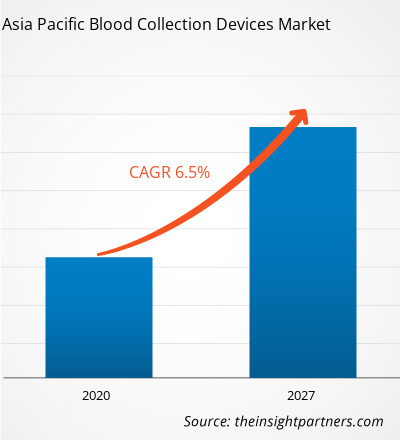The Asia Pacific blood collection devices market is expected to reach US$ 2,795.94million by 2027 from US$ 1,702.82 million in 2019; it is estimated to grow at a CAGR of 6.5% from 2020 to 2027.
Growing number of accidents and trauma cases, rising incidence of infectious diseases, and developing liquid biopsy technology are the key factors driving the growth of the market. However, shortage of skilled professionals is the major factor hindering the market growth in Asia Pacific.
Blood collection devices help in safe withdrawal of blood. Blood is collected from donor to perform various diagnostic tests. Needles & syringes, lancets, and other devices are used for arterial and venous blood collection. Arterial blood collection has various advantages such as arterial blood gas sampling, and intraoperative blood salvage.
A rise in the number of road accidents, fires, and sports injuries has led to an increase in the incidences of trauma and injuries. According to WHO, more than 700 people die in road accidents every day, and it also estimates that traffic accident claim about 260,000 deaths in China each year, of which with 60% are vulnerable road users such as pedestrians, cyclists, and motorcyclists. Current trend analysis predicts that road accidents will become the fifth-leading cause of mortality.The rising number of accidents and injuries will propel the demand blood transfusion in the coming years. Accident casualties or trauma patients often face blood loss. Thus, transfusion of blood, particularly red blood cells, is required to restore the lost blood volume. Hence, the demand for blood transfusion in trauma patients coupled with growing incidents of injuries will stimulate the growth of the Asia Pacific blood collection devices market
Traditionally, antimicrobial therapy was used cure infectious diseases; however, over the years, microbes have developed resistance against drugs, owing to which antimicrobial agents have failed to deliver the coveted results. Despite significant advancements in sanitation and therapy, there are rising cases of infectious diseases, such as human papillomavirus (HPV), hepatitis, human immunodeficiency virus (HIV), tuberculosis, and malaria. The prevalence of lifestyle ailments is also increasing. This rising prevalence of diseases will be promising for the market growth, as blood tests are a primary mode of diagnosing these conditions.
Countries in AsiaPacific are witnessing a huge challenge due to growing COVID-19. To prevent the spread of disease, restrictive measures have been taken in countries such as India, South Korea, Singapore, Malaysia, and the Philippines. According to WHO, due to the rapid outbreak of COVID-19, any additional health measures are likely to significantly interfere with international travel and trade.This has adversely affected all the industries including blood collection and its accessory equipment. In India, the number of voluntary blood donations hasreduced as the government restricts people from donating blood showing cold, fever and cough symptoms. The drastic dips in blood donations are likely to hamper the blood collection devices market in AsiaPacific.
Rest of Asia Pacific Blood Collection Devices Market,Revenue and Forecast to 2027 (US$ Mn)
- This FREE sample will include data analysis, ranging from market trends to estimates and forecasts.
ASIA PACIFICBLOOD COLLECTION DEVICES MARKET SEGMENTATION
By Product
- Blood Collection Tubes
- Micro-Collection Tubes
- Evacuated Blood Collection Tubes
- Blood Collection Needles/Holders
- Blood Collection Set
- Others
By Method
- Manual Blood Collection
- Automatic Blood Collection
By Enduser
- Hospitals and Pathology Laboratories
- Blood Banks
- Others
By Country
- China
- Japan
- India
- South Korea
- Australia
Company Profiles
- Nipro
- BD
- SEKISUI CHEMICAL CO. LTD
- Cardinal Health Inc
- Terumo Corporation
Asia Pacific Blood Collection Devices Report Scope
| Report Attribute | Details |
|---|---|
| Market size in 2019 | US$ 1,702.82 Million |
| Market Size by 2027 | US$ 2,795.94 Million |
| Global CAGR (2020 - 2027) | 6.5% |
| Historical Data | 2017-2018 |
| Forecast period | 2020-2027 |
| Segments Covered |
By Product
|
| Regions and Countries Covered | Asia-Pacific
|
| Market leaders and key company profiles |
- Historical Analysis (2 Years), Base Year, Forecast (7 Years) with CAGR
- PEST and SWOT Analysis
- Market Size Value / Volume - Global, Regional, Country
- Industry and Competitive Landscape
- Excel Dataset



Report Coverage
Revenue forecast, Company Analysis, Industry landscape, Growth factors, and Trends

Segment Covered
Product, Method, End User, and Country

Regional Scope
North America, Europe, Asia Pacific, Middle East & Africa, South & Central America

Country Scope
Australia, China, Japan, South Korea
Trends and growth analysis reports related to Life Sciences : READ MORE..
The List of Companies - Asia Pacific Blood Collection Devices Market
- Nipro
- BD
- SEKISUI CHEMICAL CO. LTD
- Cardinal Health Inc
- Terumo Corporation

 Get Free Sample For
Get Free Sample For